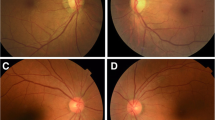Summary
BACKGROUND: Normal binocularity should be developed at the end of the 6th month of life. Intermittent esotropia after this time is not rare and may possibly change into manifest squint. Does this condition need prophylactic treatment? MATERIAL AND METHODS: 80 children, aged 6 to 24 months underwent examination with all common orthoptic methods. Additionally a new simple test (small pictures and a torch for observation) was developed to provoke accommodation. 60 of our patients were supervised over a period of average 5.7 years. RESULTS: In all cases we could trigger usually unilateral squint by an intense demand for accommodation. 57% of all patients had a hereditary taint concerning strabismus. The hypermetropia of the most cases did not exceed age-related physiological degree. 86.7% of the long-term observed patients showed orthophoria at the second birthday, independent of wearing glasses; only 13.3% developed esotropia. CONCLUSIONS: Remembering the theory of Worth we suppose an inborn defect of the control system of accommodation-convergence and fusion, that leads to a retardation of development. Spontaneous remission of intermittent squint can be expected in about 87 percent of cases. The prescription of glasses is only recommended, if the refraction error exceeds +2.0 spheric, 1.0 cylindric and 1.0 anisometropic diopters. Supervision of the children every third month and prophylaxis of amblyopia is advisable.
Zusammenfassung
HINTERGRUND: Normales Binokularsehen sollte am Ende des 6. Lebensmonats gefestigt sein. Zeitweises Konvergenzschielen danach ist nicht selten. Stellt es eine Vorstufe manifesten Schielens dar und ist es behandlungsbedürftig? MATERIAL UND METHODE: 80 Kinder, 6 bis 24 Monate alt, wurden wegen intermittierenden Konvergenzschielens mit allen üblichen orthoptischen Methoden untersucht. Hinzugefügt wurde ein neuer einfacher Test zur Provokation der Akkommodation (kleine Bildchen, Taschenlampe zur Beobachtung). 60 aller Kinder wurden über durchschnittlich 5,7 Jahre laufend kontrolliert. RESULTATE: Durch intensive Akkommodationsforderung war bei allen Kindern ein meist einseitiges Schielen auslösbar. 57% hatten eine erbliche Belastung bezüglich Strabismus. 86,7% der nachuntersuchten Fälle zeigten am Ende des 2. Lebensjahres Orthophorie, unabhängig vom Brillentragen bei altersgemäß physiologischer Hyperopie. Nur 13,3% der Kinder entwickelten ein manifestes Schielen. SCHLUSSFOLGERUNG: Die Ergebnisse sprechen nach Worth für eine erbliches Defizit im Regelkreis Akkommodation-Konvergenz-Fusion mit verzögerter Reifung. Die Aussicht auf Spontanheilung liegt bei 87%. Eine Brillenverordnung ist nur erforderlich, wenn der Refraktionsfehler +2,0 sphärische, 1,0 cylindrische oder 1,0 anisometropische Dioptrie übersteigt. Laufende Kontrollen im Abstand von 3 Monaten und Prophylaxe einer Amblyopie sind zu empfehlen.
Similar content being viewed by others
Literatur
Hamburger FA (1978) Stellungs- und Bewegungsanomalien des Augenpaares. In: Velhagen K: Der Augenarzt, 2. Aufl, Bd V. VEB Thieme, Leipzig
Wright KW, Spiegel PH, Thompson LS (2006) Handbook of Pediatric Strabismus and Amblyopia. Springer
Lang J (2003) Strabismus, 5. Aufl. Hans Huber, Bern
Stangler-Zuschrott E (1975) Strabismus convergens bei höhergradiger Hypermetropie. Klin Monatsbl Augenheilkd 167: 469–473
Author information
Authors and Affiliations
Corresponding author
Rights and permissions
About this article
Cite this article
Stangler-Zuschrott, E. Die Bedeutung und Prognose intermittierenden Konvergenzschielens bei 6 bis 24 Monate alten Kindern. Spektrum Augenheilkd. 24, 220–223 (2010). https://doi.org/10.1007/s00717-010-0418-6
Issue Date:
DOI: https://doi.org/10.1007/s00717-010-0418-6




